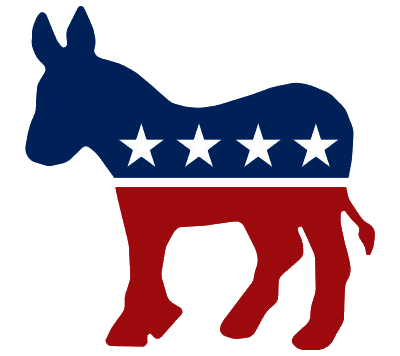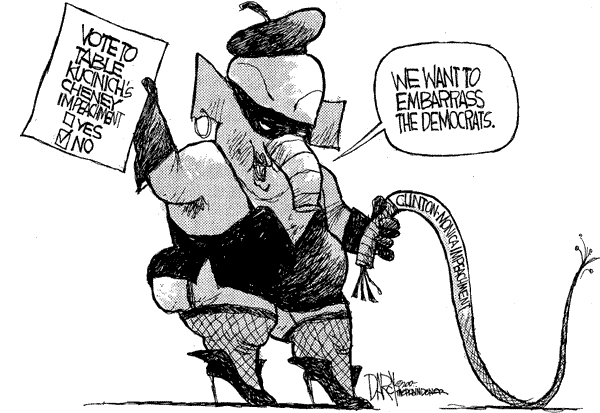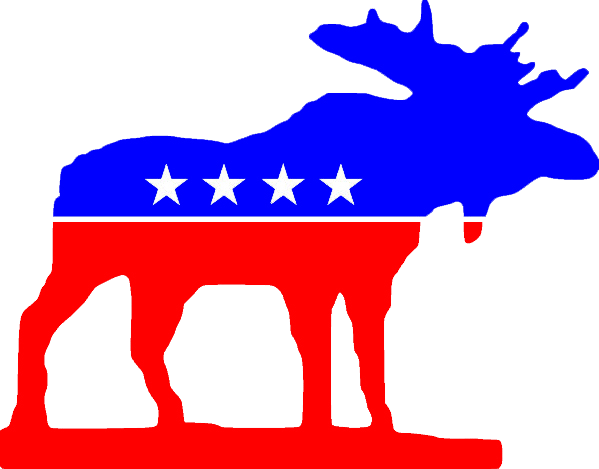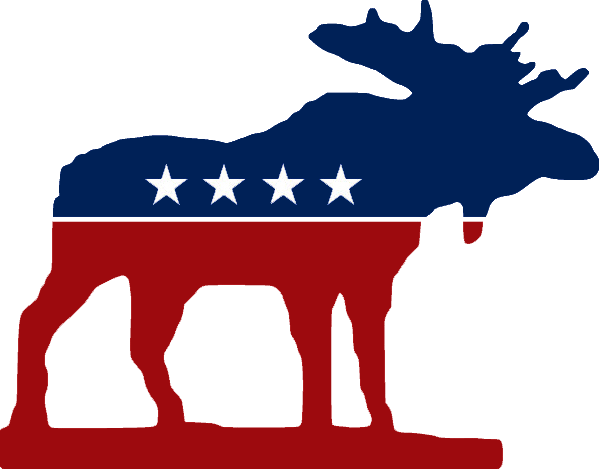No, this isn’t what you’re probably thinking. Yet. Whether it becomes that depends entirely on how things turn out by the end of the year. No, this is about nothing more than the Democratic Party’s animal mascot.

Nice, huh? Too bright for your eyes? Here’s one in a darker color scheme.

Join me below the fold for more.
I’ve given this a lot of thought, and I’ve decided that we need to retire the Democratic Donkey as our mascot. He’s a politically savvy beast, to be sure. But he’s been around since Andrew Jackson ran for the presidency, and frankly, he’s worn out.
A little bit of political history is in order, so you understand what I’m writing about.
The now-famous Democratic donkey was first associated with Democrat Andrew Jackson’s 1828 presidential campaign. His opponents called him a jackass (a donkey), and Jackson decided to use the image of the strong-willed animal on his campaign posters. Later, cartoonist Thomas Nast used the Democratic donkey in newspaper cartoons and made the symbol famous.
Nast invented another famous symbol—the Republican elephant. In a cartoon that appeared in Harper’s Weekly in 1874, Nast drew a donkey clothed in lion’s skin, scaring away all the animals at the zoo. One of those animals, the elephant, was labeled “The Republican Vote.” That’s all it took for the elephant to become associated with the Republican Party.
Democrats today say the donkey is smart and brave, while Republicans say the elephant is strong and dignified.
Now, given the history of the last thirty years or so, that last bit isn’t even close to being accurate anymore. The Republican Elephant may be strong, but it is hardly dignified. To illustrate this salient point, I offer the following:

And then, of course, there’s the Daily Kos front page entry from yesterday describing the hissy fit over contempt charges against Harriet Miers and Josh Bolton, led by House Republican leader John Boehner (he of the whiny tears and unintentionally pornographic-sounding surname).
So the Republican Elephant may be strong — certainly enough to continue bullying Democrats into craven submission in spite of no longer being the majority party in Congress. But the word ‘dignified’ isn’t a word that may be used to describe it.
And then, of course, there’s tired old Mr. Donkey. He who used to be smart, and who used to be brave, but whose age and senility began creeping up and finally hit it like a super case of Alzheimer’s about the time Reagan won the presidency. Sorry if the Alzheimer’s reference offends, but you have to understand what has become of the Democratic Party and why the Donkey no longer symbolizes intelligence or bravery.
Now, it should be noted that until very recently in American history the Donkey had certainly lived up to its reputation. But this wasn’t always so. A look at presidential history shows that before Franklin Delano Roosevelt swept to victory on a tide of anti-Republican outrage following the Great Depression, there were more Republican presidents than Democratic ones. Nineteen GOPers (eighteen if you discount the illegitimate dictatorship of George W. Bush) to the Democrats’ thirteen. Let’s take a look, however, at the post-American Civil War through the Gilded Age.
From 1861 to 1885, Lincoln to Arthur, there was an unbroken line of Republican presidents. Grover Cleveland won the 1884 presidential election, but was voted out after one term in favor of GOPer Benjamin Harrison, only to win re-election in 1892. After that, it was another unbroken line of Republican presidencies from 1897 to 1913. And following Democrat Woodrow Wilson’s two terms, Herbert Hoover presided over the collapse of the American economy.
I want you to think about that for a few minutes. From 1861 to 1933 — seventy-two years — only sixteen non-consecutive years saw Democratic presidencies. Needless to say, Donkey’s early decades were not exactly fruitful ones. But something odd happened in the early 20th Century that upset the balance of power for decades to come. And that something was Theodore Roosevelt.
The 26th president of the United States could, arguably, be considered the most Progressive Republican to win the presidency. He might, arguably, also be considered the only Progressive Republican to reside there. At any rate, having served in office for nearly eight years (his predecessor, William McKinley, was assassinated in September 1901) he thought he had earned a rest from politics. So he named his chosen successor, William Howard Taft, and went hunting. The next four years under the 27th president, however, did not go well for the Progressive movement. Taft undid or allowed to expire many of the Progressive reforms his predecessor had pushed through Congress.
Needless to say, Roosevelt was not pleased with what he saw when he got back from safari. Incensed at what his hand-picked successor had done to his legacy, Roosevelt determined that he would run again for the presidency. Although he came close to winning the Republican nomination, however, Taft managed to eke out the victory. Roosevelt wasn’t about to accept defeat, though. So, taking a good many of his fellow progressives with him, he formed the Progressive Party to continue running. In so doing, most Progressives left the GOP and the party would come to be dominated by conservatives until the present day.
Nicknamed the Bull Moose Party after a statement by Roosevelt on how he felt, in response to a reporter’s question (the former president had survived an assassination attempt, and his safari adventures had proven disastrous to his health), Theodore led a fierce campaign for the presidency. But the Progressive movement had split, with some going over to their namesake political party and others switching their affiliation to the Democrats. The final result of the 1916 race was that Democrat Woodrow Wilson won, with Taft becoming the first and only incumbent president to come in last in a three-way election.
Following Wilson’s victory, Democrats held the office of the presidency for eight years. But it didn’t last. It wouldn’t be until the markets collapsed in 1929 that voter outrage coalesced into a stronger Progressive movement led by unions and another Roosevelt — Franklin, a cousin of Theodore. FDR was able to put together a coalition that for the first time in the nation’s history was powerful enough to transform politics for generations. Democrats not only won the presidency, but Congress as well. And they kept the Legislature for over forty years.
Paul Krugman, he who wrote The Conscience of A Liberal (which really should be required reading for all Progressives), laid out the case for why this Democratic reign lasted as long as it did — as well as why it eventually collapsed. But the point is, the Donkey had finally proven itself the victor and lived up to the reputation of its political party. Even when GOPers held the presidency, during the terms of Dwight Eisenhower and Richard Nixon, the party remained quite strong.
But, as with all good things, the Great Compression came to an end. As Krugman explains in his book, the New Deal coalition was a shaky one from the start: a marriage of convenience between Northern liberals and Southern Dixiecrats. When the party leaders began trying to expand the New Deal to health care reform, and especially when they began standing up for the Civil Rights movement, the Dixiecrats balked and went over to the GOP. In droves. This coincided with the rise of movement conservatism within the Republican Party, and the New Deal coalition fell apart. By the time Nixon resigned from the presidency in disgrace, the Democratic Party had become a shell of its former self. And things became worse when the GOP was able to exploit racism and a hostage crisis in Iran to defeat Jimmy carter in 1980.
The rest, as they say, is history. The rise of the conservative Democratic Leadership Council and the capitulation of Democrats during Iran-Contra helped weaken the party further. Bill Clinton, the only Democrat to win and hold the presidency during the last twenty-eight years, was a weak and ineffectual president who caved to the GOP on virtually every front. The truth is, the Clinton dynasty has ever been about one thing: the Clintons. It was never about trying to work on behalf of the American people; it’s always been about them, and only them. And they don’t care that it has destroyed the Democratic Party.
Which is why it is so frustrating to see the once-mighty Democrats brought so low despite having been voted back into power in 2006. Even though we have control of Congress, the party leaders are so whipped that to even suggest impeachment of the criminal Bush-Cheney regime is to invite scorn and punishment. Just ask Dennis Kucinich, he who managed to force a debate on impeachment last year and whose efforts are being assisted by Robert Wexler. He now faces a stiff primary battle for his Ohio-10th House seat.
The lesson to be learned from the past thirty years is that time has not been kind to the Democratic Donkey. Yes, he’s smart. But age and the burden of holding up the Progressive Reforms of the 20th Century have worn him out. He is, to put it bluntly, ruined. Tired. Weak. No longer brave. And not as quick with his wits as he used to be. It’s time for him to take a badly needed rest. The Democratic Donkey needs, desperately, to retire.
Something needs to be done to help reinvigorate the Progressive Movement. And I can’t think of a better symbol with which to replace the Democratic Donkey than the animal mascot that made a sitting president come in last. I’m writing, dear readers, about the Progressive Bull Moose. He has spent nearly a century sitting idle, and he is chomping at the proverbial bit to take his rightful place as a national Party Mascot. Take a gander at this:


And tell me that isn’t a strong, proud, fine animal to rally ourselves around. Look at that majestic beast and tell me it can’t spark a renewed sense of pride and energy in the Progressive Movement. You can’t, not with a straight face, anyway.
Think what such a mascot would look like up against the GOP symbol. The Republican Pachyderm may be strong, but that is now its only virtue. And that “virtue” is highly dubious, because it is just as old and senile as the Donkey. It remains on top of the mascot heap solely through the use of brute force. It has become greedy, slothful, and stupid. Which is why adopting the Bull Moose as our new national party symbol has such potential to reinvigorate us.
So what do you say? Shall we retire the Donkey?




